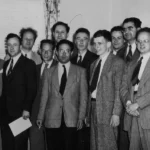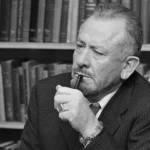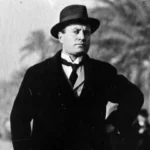The Apple TV+ miniseries “Masters of the Air” has captivated audiences with its gripping portrayal of the 100th Bomb Group during World War II. Among the many courageous airmen whose stories are interwoven into the narrative is Lt. Curtis Biddick, portrayed by Barry Keoghan. While the show offers a glimpse into the harrowing realities faced by these young men, the real Lt. Biddick’s story runs even deeper, revealing the true cost of bravery in the skies above Nazi-occupied Europe. This article aims to uncover the truth about Lt. Curtis Biddick, separating fact from fiction and exploring the lasting legacy of this American hero.
The Real Man Behind “Masters of the Air”
Born on April 20, 1915, in Livingston, Wisconsin, Curtis Rundle Biddick’s life was tragically cut short on August 17, 1943, during a perilous bombing mission over Regensburg, Germany. As a First Lieutenant and skilled pilot in the U.S. Army Air Forces, Biddick served with the 351st Bomb Squadron, forming part of the renowned 100th Bomb Group of the 8th Air Force. Known for his leadership and courage, Biddick piloted a B-17 bomber affectionately nicknamed “Bad Penny” – a poignant symbol of the constant danger he and his crew faced.
“Masters of the Air” introduces viewers to Biddick as an energetic and brave young pilot, a portrayal likely rooted in historical accounts. However, the true depth of his character, the values he held dear, and the impact he had on those around him deserve further exploration beyond the screen. What we do know is that Biddick, like so many others who served, was thrust into the crucible of war, his fate a stark reminder of the sacrifices made by the “Greatest Generation.”
The Fateful Regensburg Mission
Episode 3 of “Masters of the Air” depicts the events leading to the tragic loss of Biddick and his crew. As the episode unfolds, viewers witness the “Bad Penny” sustain severe damage, leaving its fate precariously hanging in the balance. The episode suggests that Biddick, in a final act of selflessness, attempts a crash landing in an effort to save his co-pilot. The narrative concludes with an air of uncertainty, mirroring the agonizing experience of those on the ground left wondering about the fate of their comrades. It’s not until Episode 5 that Biddick’s death during the Regensburg mission is confirmed, adding a poignant layer of realism to the series.
Historically, the Regensburg mission, a pivotal event in the air war over Europe, serves as a chilling reminder of the high cost of victory. The mission, targeting German industrial centers, was part of a larger strategic bombing campaign intended to cripple the Nazi war machine. Biddick and his crew, like many others on that fateful day, were tasked with a diversionary attack, drawing enemy fire away from the main force. This tactic, while strategically vital, often meant facing overwhelming odds and placed these brave airmen in harm’s way.
Honoring a Legacy: Biddick’s Enduring Impact
While the exact details of Biddick’s final moments may remain shrouded in the fog of war, his legacy extends far beyond the tragic events of August 17, 1943. “Masters of the Air,” through Barry Keoghan’s moving performance, has played a crucial role in reigniting interest in Biddick’s story and the sacrifices of those who served in the 8th Air Force. The series, while fictionalized, has inspired viewers to delve deeper into the real-life stories behind the characters, bringing attention to the bravery and resilience of a generation tested by war.
Biddick’s story serves as a potent reminder of the human cost of conflict, prompting us to consider the individual lives tragically cut short and the profound impact on families and loved ones left behind. The outpouring of interest in Biddick’s life following the release of “Masters of the Air” highlights the power of storytelling and its ability to bridge the gap between historical events and personal experiences.
Uncovering More: A Call to Further Exploration
While “Masters of the Air” offers a poignant introduction to Lt. Curtis Biddick, his story, like those of countless others who served, deserves further exploration. Resources such as the American Air Museum, with its meticulously preserved records and accounts, offer invaluable insights into the lives of these airmen. Through continued research and investigation, we can gain a deeper understanding of the man behind the uniform, the missions he flew, and the sacrifices he made in service to his country. By piecing together the fragments of history, we ensure that the legacy of Lt. Curtis Biddick, and those who served alongside him, continues to inspire and resonate for generations to come.
For further exploration, consider these compelling avenues:
- The Regensburg Mission: Dive deeper into the historical context of this pivotal mission, examining its significance, the challenges faced by the aircrews, and the devastating losses incurred.
- The Human Cost: Explore the psychological toll of war on the airmen, using Biddick’s story as a lens to understand the enduring impact of combat stress, survivor’s guilt, and the loss of comrades.
- Beyond the Battlefield: Research any memorials dedicated to Biddick and his crew, and delve into the legacy of the 100th Bomb Group and the ongoing efforts to commemorate their sacrifices.
Did you know that the beautiful Cindy Costner’s massive contribution to the film industry has resulted in her remarkable net worth? On the other hand, let’s unveil the fascinating story behind Derek Bryceson’s sensational rise to fame and fortune.

















2 thoughts on “Curtis Biddick: The True Story Behind the Masters of the Air Pilot”
Comments are closed.